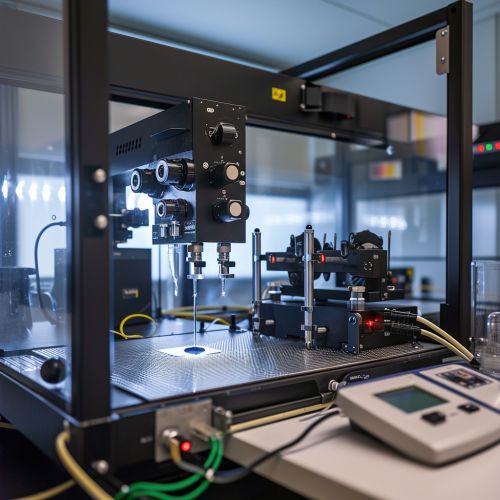Ultrafast optics
Introduction
Ultrafast optics is a branch of optics that deals with the study and application of light pulses with durations in the femtosecond (10^-15 seconds) to attosecond (10^-18 seconds) range. This field has seen significant advancements in recent years due to the development of ultrafast laser technology, which has opened up new avenues for research in areas such as quantum mechanics, biophysics, and material science.


Ultrafast Laser Technology
Ultrafast laser technology is the backbone of ultrafast optics. These lasers produce pulses of light that are extremely short in duration, typically in the femtosecond to attosecond range. The most common type of ultrafast laser is the mode-locked laser, which uses a technique called mode-locking to generate a train of ultrafast pulses.
Mode-Locking
Mode-locking is a technique used in lasers to generate ultrafast pulses of light. In a mode-locked laser, all the resonant modes of the laser cavity are made to oscillate in phase with each other, resulting in a laser beam that consists of a train of ultrafast pulses. This is achieved by introducing a mode-locking element into the laser cavity, which modulates the loss or gain of the laser medium at a frequency equal to the round-trip frequency of the cavity.
Types of Ultrafast Lasers
There are several types of ultrafast lasers, each with their own unique characteristics and applications. Some of the most common types include:
- Titanium-sapphire lasers: These are the most widely used ultrafast lasers, capable of generating pulses as short as a few femtoseconds. They are often used in research applications due to their broad tunability and high peak power.
- Fiber lasers: These lasers use an optical fiber as the gain medium, which allows for the generation of ultrafast pulses with high stability and reliability. They are often used in industrial applications due to their robustness and compact size.
- Dye lasers: These lasers use an organic dye as the gain medium, which allows for a wide range of tunability. They can generate ultrafast pulses, but are less commonly used due to their complexity and the need for frequent dye changes.
Ultrafast Phenomena
Ultrafast optics is used to study a variety of ultrafast phenomena, which are processes that occur on a timescale of femtoseconds to attoseconds. These phenomena are often too fast to be observed with traditional optical techniques, making ultrafast optics a crucial tool in their study.
Femtosecond Processes
Femtosecond processes are those that occur on a timescale of 10^-15 seconds. These include processes such as the motion of electrons in atoms and molecules, the formation and breaking of chemical bonds, and the relaxation of excited electronic states in semiconductors.
Attosecond Processes
Attosecond processes are those that occur on a timescale of 10^-18 seconds. These include processes such as the motion of electrons in atoms and molecules, and the ionization of atoms by high-intensity laser pulses.
Applications of Ultrafast Optics
Ultrafast optics has a wide range of applications in various fields of science and technology. Some of the most notable applications include:
- Spectroscopy: Ultrafast lasers are used in spectroscopy to probe the dynamics of atoms, molecules, and solids on a femtosecond to attosecond timescale. This allows for the study of ultrafast processes such as chemical reactions, electron dynamics, and energy transfer processes.
- Microscopy: Ultrafast lasers are used in microscopy to image biological samples with high spatial and temporal resolution. This allows for the study of dynamic processes in living cells, such as protein interactions, signal transduction, and cellular metabolism.
- Material processing: Ultrafast lasers are used in material processing for tasks such as cutting, drilling, and welding. The short pulse duration of ultrafast lasers allows for precise material removal with minimal heat affected zone, making them ideal for processing sensitive materials.
- Telecommunications: Ultrafast lasers are used in telecommunications for high-speed data transmission. The short pulse duration of ultrafast lasers allows for high data rates, making them ideal for use in fiber-optic communication systems.
